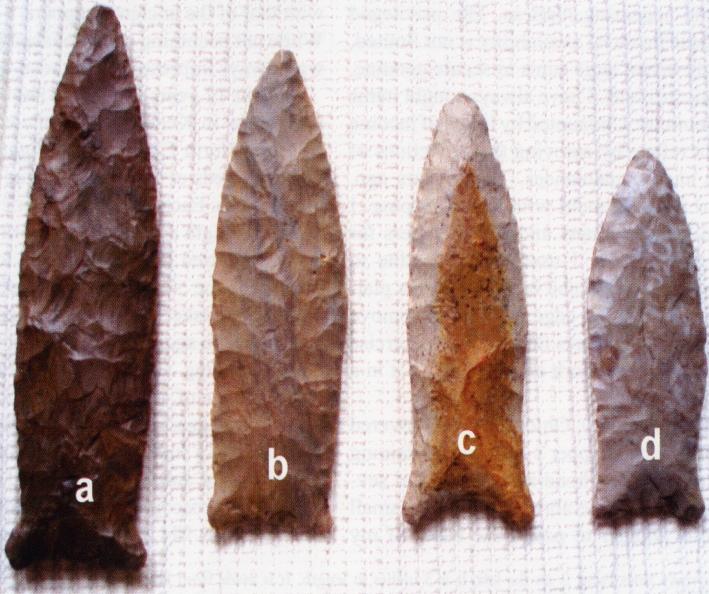by William Pettit, Crossville, Tennessee
For a number of years I have been interested in the form and typology of the Beaver Lake point (Pettit). Some Pike County and Beaver Lake points have a number of attributes in common Both can have very similar forms and the refined and almost exquisite flaking characteristic of the Late Paleo and Early Archaic periods that came to fruition in the Dalton Tradition. The form of one particular variant of the Pike County is striking similar to classical Beaver Lake. Note the similarity in form of the point in figure 1 (b, Pike County) to those in figure 2 (c and d, Beaver Lakes). All three demonstrate fine pressure flaking to produce thin lenticular cross sections of the blade, delicate basal ears, and relative straight blade edges. In addition, the time periods during which they were produced coincide and it has been suggested that the two types may be culturally related (Perino).
Although the distribution of Pike County points and Beaver Lake points overlap, primarily in southern Illinois, and neighboring parts of Kentucky (Perino), the centers of their respective distributions are quite different. Beaver Lakes are found primarily in north Alabama, Tennessee, Kentucky, but they are also found in adjoining areas of adjacent states. Pike County points are centered, but not limited to the areas surrounding Pike Counties in Illinois and Missouri, hence the name. These similarities in form and differences in distributions posed the interesting question as to the cultural relationship of the two types.

Figure 1.
a, Morgan Co., Missouri, mozarkite; b, Pike Co., Illinois, Burlington. Longest piece is 3 9/16 inch.
The point shown in figure 1 (a) was found in Missouri and has a form (shape) that is quite similar to the Pike County point (figure 1 b); however, the similarity ends there. The larger point is crudely flaked principally by percussion. Indeed, it looks “roughed out” and does not have the careful grinding of the lateral haft or basal area of a finished Pike County point. I considered it to be likely that this larger point was a preform of the Pike County point which with the application of careful pressure flaking and a corresponding reduction in size, could produce a refined Pike County point. Previously I had not considered the possibility that a comparison of preforms of Pike County and Beaver Lake points might shed some light on the cultural and developmental differences and similarities between the two types.

Figure 2.
a, Wilson Co., Tennessee, Ft.Payne?; b, Madison Co., Alabama, Ft.Payne;
c, Madison Co., Kentucky, unidentified; d, Tennessee, Ft.Payne. Longest piece is 3 5/16 inch.
Figure 2 (a and b) shows examples of what I consider to be end stage preforms of Beaver Lake points. Although both are finely flaked, as are their finished brethren (2, c and d) some interesting differences remain. The point tips of the first two a and b) are deliberately left blunt (unfinished) as if broken off. The breaks do not resemble impact fractures and the planes of the breaks are nearly perpendicular to the blade axis. I also noted that the blade edges abruptly terminate at the laterally projecting basal ears. The careful recurved finishing of the hafting area, i.e., the crafting of the “waist” has not been done, nor the haft/basal grinding I think these features strongly indicate unfinished specimens. If I have correctly identified the preforms of the two types, then a comparison of the respective features indicates a diverse cultural origin that resulted in a similar outcome or convergence to a similar finished product. Although my postulations regarding the possible cultural and developmental distinctions between Pike County and Beaver Lake points have included a number of assumptions, they seem reasonable. Perhaps further excavation and study will either support or disprove my conclusions.
